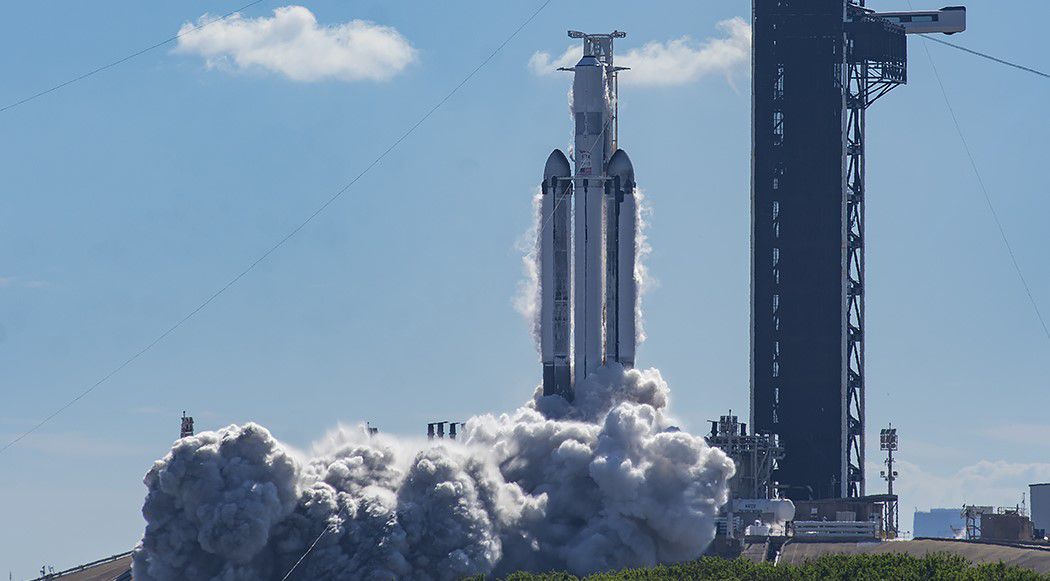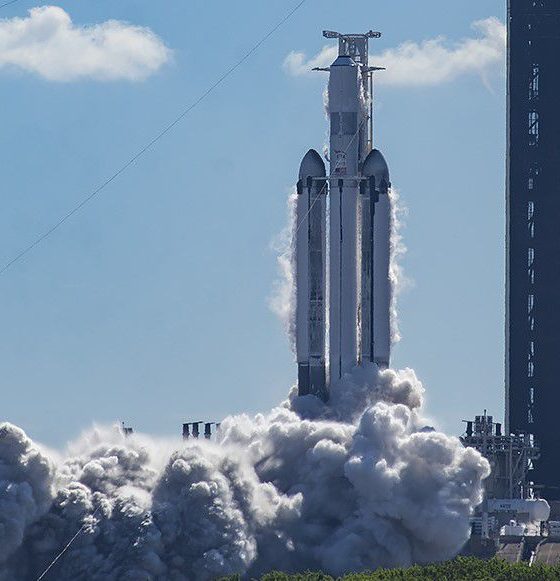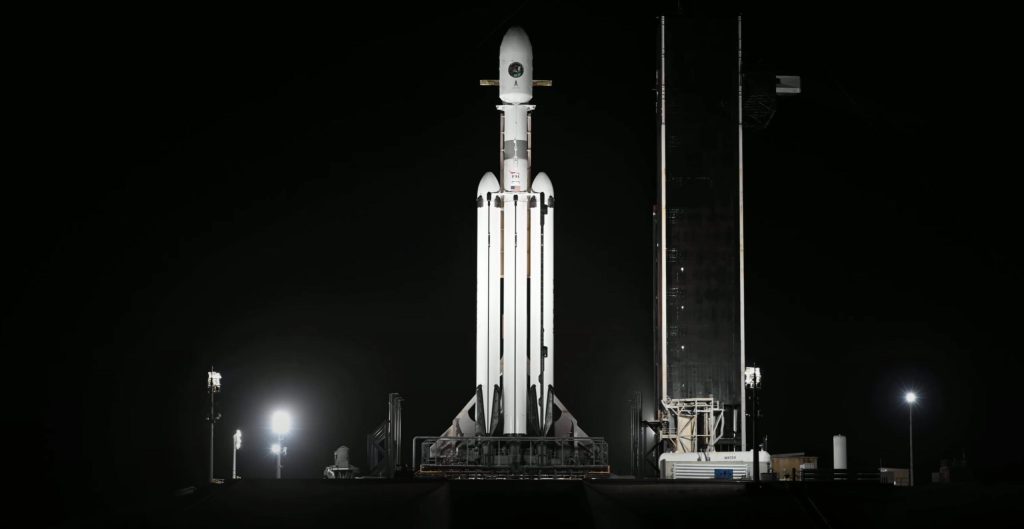

News
SpaceX’s fifth Falcon Heavy launch on track for Sunday liftoff
Update: SpaceX’s fifth Falcon Heavy launch is on track to launch as early as 5:56 pm EST (22:56 UTC), Sunday, January 15th. Tune in below around 5:40 pm EST (22:40 UTC) to watch the potentially spectacular launch live.
If Falcon Heavy does launch shortly after sunset, it could put on a spectacular show, lighting up the twilight skies for hundreds of miles up and down the East Coast.
The fifth Falcon Heavy rolled out of SpaceX’s Kennedy Space Center Pad 39A integration hangar on January 9th and went vertical early on January 10th. 12 hours later, it was loaded with ~1500 tons (~3.3 million lbs) of liquid oxygen and kerosene propellant and ignited for about eight seconds. SpaceX uses static fire tests more liberally than most other launch providers to try to ensure that all systems – propulsion included – are cooperating before liftoff.
The update that's rolling out to the fleet makes full use of the front and rear steering travel to minimize turning circle. In this case a reduction of 1.6 feet just over the air— Wes (@wmorrill3) April 16, 2024
At full throttle, Falcon Heavy Block 5’s 27 Merlin 1D engines – nine per Falcon 9-derived booster – can produce 2326 tons (5.13 million lbf) of thrust at sea level, making it the most powerful privately-developed rocket in history. In terms of performance, Falcon Heavy is the fifth most capable rocket ever built and is second only to NASA’s Space Launch System (SLS) today. While the records of N1, Saturn V, and Energia still stand, all three were retired decades ago.
As is the norm for a rocket with as little experience as Falcon Heavy, SpaceX conducted the static fire test without the USSF-67 payload installed. Like USSF-44, a virtually identical Falcon Heavy launch with similar payloads that launched on November 1st, 2022, SpaceX needs to roll the USSF-67 rocket back to the hangar for fairing installation. During USSF-44, SpaceX took approximately 110 hours to go from static fire to liftoff.
USSF-67’s static fire occurred about 100-104 hours before its scheduled liftoff, meaning that SpaceX only needs to be about 5% more efficient to be ready to launch on Saturday, January 14th. Assuming Falcon Heavy returns to the hangar and rolls back to the pad about as quickly as USSF-44, the odds of a Saturday launch are decent.



SpaceX’s second direct GEO launch
Like USSF-44, Falcon Heavy will sacrifice one of its three boosters (the center core) to launch USSF-67 directly to a circular geosynchronous orbit ~35,800 kilometers (~22,250 mi) above Earth’s surface. A satellite operating at GSO will never stray from the same region of Earth, making it useful for communications and surveillance. Getting there, however, can be exceptionally difficult.
“To simplify the rocket’s job, most GEO-bound satellites are launched into an elliptical geosynchronous or geostationary transfer orbit (GTO) and use their own propulsion to circularize that ellipse.
On a direct-to-GEO launch, the rocket does almost all of the work. After reaching a parking orbit in Low Earth Orbit (LEO), Falcon Heavy’s upper stage will complete a second burn to reach GTO. Then, while conducting a complex ballet of thermal management and tank pressure maintenance to prevent all of its cryogenic liquid oxygen (LOx) from boiling into gas and its refined kerosene (RP-1) from freezing into an unusable slush, the upper stage must coast ‘uphill’ for around five or six hours.
During that journey from 300 kilometers to 35,800 kilometers, the upper stage must also survive passes through both of Earth’s Van Allen radiation belts. At apogee, Falcon S2 must reignite its Merlin Vacuum engine for a minute or two to reach a circular GSO. Payload deployment follows soon after and could last anywhere from a few minutes to hours. Finally, to be a dutiful space tenant, Falcon’s upper stage must complete at least one more burn to reach a graveyard orbit a few hundred kilometers above GEO.”
Teslarati.com – November 1st, 2023
The USSF-67 payload is mostly a mystery. Like USSF-44, it will carry a Northrop Grumman LDPE (Long Duration Propulsive EELV) with several unspecified rideshare payloads. LPDE is a transfer vehicle capable of deploying small satellites into customized orbits and hosting payloads for months in space.
The US Space Systems Command says [PDF] that “LDPE provides critical data to inform future Space Force programs” and that “the unique experiments and prototype payloads hosted on LDPE-3A [will] advance warfighting capabilities in the areas of on-orbit threat assessment, space hazard detection, and space domain awareness.”
Stay tuned for updates on USSF-67’s launch schedule and SpaceX’s official webcast.

Elon Musk
Elon Musk’s X will start using a Tesla-like software update strategy
The initiative seems designed to accelerate updates to the social media platform, while maintaining maximum transparency.

Elon Musk’s social media platform X will adopt a Tesla-esque approach to software updates for its algorithm.
The initiative seems designed to accelerate updates to the social media platform, while maintaining maximum transparency.
X’s updates to its updates
As per Musk in a post on X, the social media company will be making a new algorithm to determine what organic and advertising posts are recommended to users. These updates would then be repeated every four weeks.
“We will make the new 𝕏 algorithm, including all code used to determine what organic and advertising posts are recommended to users, open source in 7 days. This will be repeated every 4 weeks, with comprehensive developer notes, to help you understand what changed,” Musk wrote in his post.
The initiative somewhat mirrors Tesla’s over-the-air update model, where vehicle software is regularly refined and pushed to users with detailed release notes. This should allow users to better understand the details of X’s every update and foster a healthy feedback loop for the social media platform.
xAI and X
X, formerly Twitter, has been acquired by Elon Musk’s artificial intelligence startup, xAI last year. Since then, xAI has seen a rapid rise in valuation. Following the company’s the company’s upsized $20 billion Series E funding round, estimates now suggest that xAI is worth tens about $230 to $235 billion. That’s several times larger than Tesla when Elon Musk received his controversial 2018 CEO Performance Award.
As per xAI, the Series E funding round attracted a diverse group of investors, including Valor Equity Partners, Stepstone Group, Fidelity Management & Research Company, Qatar Investment Authority, MGX, and Baron Capital Group, among others. Strategic partners NVIDIA and Cisco Investments also continued support for building the world’s largest GPU clusters.
News
Tesla FSD Supervised wins MotorTrend’s Best Driver Assistance Award
The decision marks a notable reversal for the publication from prior years, with judges citing major real-world improvements that pushed Tesla’s latest FSD software ahead of every competing ADAS system.

Tesla’s Full Self-Driving (Supervised) system has been named the best driver-assistance technology on the market, earning top honors at the 2026 MotorTrend Best Tech Awards.
The decision marks a notable reversal for the publication from prior years, with judges citing major real-world improvements that pushed Tesla’s latest FSD software ahead of every competing ADAS system. And it wasn’t even close.
MotorTrend reverses course
MotorTrend awarded Tesla FSD (Supervised) its 2026 Best Tech Driver Assistance title after extensive testing of the latest v14 software. The publication acknowledged that it had previously criticized earlier versions of FSD for erratic behavior and near-miss incidents, ultimately favoring rivals such as GM’s Super Cruise in earlier evaluations.
According to MotorTrend, the newest iteration of FSD resolved many of those shortcomings. Testers said v14 showed far smoother behavior in complex urban scenarios, including unprotected left turns, traffic circles, emergency vehicles, and dense city streets. While the system still requires constant driver supervision, judges concluded that no other advanced driver-assistance system currently matches its breadth of capability.
Unlike rival systems that rely on combinations of cameras, radar, lidar, and mapped highways, Tesla’s FSD operates using a camera-only approach and is capable of driving on city streets, rural roads, and freeways. MotorTrend stated that pure utility, the ability to handle nearly all road types, ultimately separated FSD from competitors like Ford BlueCruise, GM Super Cruise, and BMW’s Highway Assistant.
High cost and high capability
MotorTrend also addressed FSD’s pricing, which remains significantly higher than rival systems. Tesla currently charges $8,000 for a one-time purchase or $99 per month for a subscription, compared with far lower upfront and subscription costs from other automakers. The publication noted that the premium is justified given FSD’s unmatched scope and continuous software evolution.
Safety remained a central focus of the evaluation. While testers reported collision-free operation over thousands of miles, they noted ongoing concerns around FSD’s configurable driving modes, including options that allow aggressive driving and speeds beyond posted limits. MotorTrend emphasized that, like all Level 2 systems, FSD still depends on a fully attentive human driver at all times.
Despite those caveats, the publication concluded that Tesla’s rapid software progress fundamentally reshaped the competitive landscape. For drivers seeking the most capable hands-on driver-assistance system available today, MotorTrend concluded Tesla FSD (Supervised) now stands alone at the top.
News
Elon Musk’s Grokipedia surges to 5.6M articles, almost 79% of English Wikipedia
The explosive growth marks a major milestone for the AI-powered online encyclopedia, which was launched by Elon Musk’s xAI just months ago.

Elon Musk’s Grokipedia has grown to an impressive 5,615,201 articles as of today, closing in on 79% of the English Wikipedia’s current total of 7,119,376 articles.
The explosive growth marks a major milestone for the AI-powered online encyclopedia, which was launched by Elon Musk’s xAI just months ago. Needless to say, it would only be a matter of time before Grokipedia exceeds English Wikipedia in sheer volume.
Grokipedia’s rapid growth
xAI’s vision for Grokipedia emphasizes neutrality, while Grok’s reasoning capabilities allow for fast drafting and fact-checking. When Elon Musk announced the initiative in late September 2025, he noted that Grokipedia would be an improvement to Wikipedia because it would be designed to avoid bias.
At the time, Musk noted that Grokipedia “is a necessary step towards the xAI goal of understanding the Universe.”
Grokipedia was launched in late October, and while xAI was careful to list it only as Version 0.1 at the time, the online encyclopedia immediately earned praise. Wikipedia co-founder Larry Sanger highlighted the project’s innovative approach, noting how it leverages AI to fill knowledge gaps and enable rapid updates. Netizens also observed how Grokipedia tends to present articles in a more objective manner compared to Wikipedia, which is edited by humans.
Elon Musk’s ambitious plans
With 5,615,201 total articles, Grokipedia has now grown to almost 79% of English Wikipedia’s article base. This is incredibly quick, though Grokipedia remains text-only for now. xAI, for its part, has now updated the online encyclopedia’s iteration to v0.2.
Elon Musk has shared bold ideas for Grokipedia, including sending a record of the entire knowledge base to space as part of xAI’s mission to preserve and expand human understanding. At some point, Musk stated that Grokipedia will be renamed to Encyclopedia Galactica, and it will be sent to the cosmos.
“When Grokipedia is good enough (long way to go), we will change the name to Encyclopedia Galactica. It will be an open source distillation of all knowledge, including audio, images and video. Join xAI to help build the sci-fi version of the Library of Alexandria!” Musk wrote, adding in a later post that “Copies will be etched in stone and sent to the Moon, Mars and beyond. This time, it will not be lost.”








